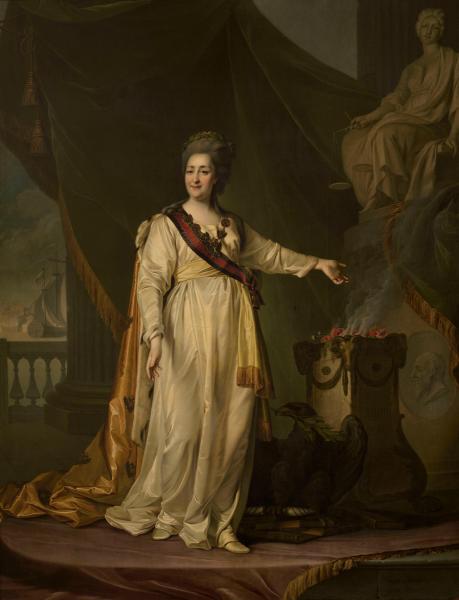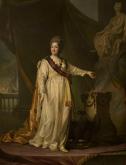Portrait of Catherine II the Legislatress in the Temple of the Goddess of Justice
1783
- oil on canvas. 261 x 201
- Ж-4998
Пост. в 1927 из ГЭ, ранее (с 1882) - Романовская галерея Зимнего дворца; Английский дворец (Петергоф); собр. князя А. А. Безбородко (Санкт-Петербург)
-
Location in museum
The Mikhailovsky Palace,
Room 10
 Open the panorama of the hall in the virtual tour
Open the panorama of the hall in the virtual tour
- Period Late 17th century – the 18th century
- Portrait
- Share
Catherine II (the Great; 1729–1796), née Princess Sophie Friederike Auguste von Anhalt-Zerbst-Dornburg, was born in the Prussian city of Stettin. In 1744, she arrived in Russia as the bride of Grand Duke Pyotr Fyodorovich, the future Emperor Peter III. That same year, she converted to Russian Orthodoxy and took the name Ekaterina Alexeevna. She married Pyotr Fyodorovich in August 1745. In 1754, she gave birth to an heir, the future Emperor Paul I. The relationship with her husband did not work out, and he planned to have her sent to a convent. In the summer of 1762, she led a conspiracy with his guards and overthrew Peter III, becoming Empress. In the first years of her reign, she adhered to a policy of "enlightened absolution", but after the peasant rebellion led by Emelyan Pugachev (1773–1775) and the French Revolution (1789), she was forced to toughen her regime. She led victorious campaigns against Turkey (1768‒1774; 1787–1792) and Sweden (1788–1790). During her reign, Crimea (1783), the Northern Baltic Sea, the Baltic states, the eastern part of Poland and the Aleutian Islands became part of Russia. Russian settlements were established in Alaska. Russia's prestige in Europe increased manifold. Catherine II is depicted with the Order of St Andrew (ribbon, star and cross).

